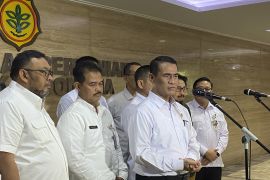"I urge all ranks of the ministry to strengthen their collaboration with the National Police because we are facing El Nino and other crises," Agriculture Minister Syahrul Yasin Limpo stated here on Tuesday.
Based on the Statistics Indonesia (BPS) survey in 2020, there were 169,788 rice mills in Indonesia.
In detail, the number of small-scale rice mills in 2020 amounted to 161,400 units; medium-scale mills, 7,332 units; and large-scale mills, 1,056 units.
Minister Limpo said that his side has set three different zones on regions throughout the country to face El Nino that is causing a long dry season that is expected to last until September.
Regions determined as red zones are considered to be deficient in water supply, while the yellow zones signify sufficient supply of water, and green zones have abundant water supplies.
Limpo said green zone regions must be strengthened in terms of their water availability.
"I have divided the regions into zones. Out of the 38 provinces, the red ones are Papua, Bali, and Banten, but many others are yellow and some are green, which need to be strengthened," he stated.
Furthermore, the government offers the smallholder business credit (KUR) for small-scale farmers looking to develop their agricultural businesses.
The KUR is a credit scheme, with low interest, that can be accessed by anyone to strengthen their business capital.
The ministry is also bolstering rice planting in six provinces in a total area of 500 thousand hectares.
The six provinces comprise North Sumatra, South Sumatra, West Java, Central Java, East Java, South Sulawesi, and Lampung as the buffer area.
Related news: Govt extends rice assistance distribution for October-December period
Related news: Rice stock secure in facing El Niño peak: Agriculture Minister
Translator: Kuntum R, Kenzu
Editor: Rahmad Nasution
Copyright © ANTARA 2023












